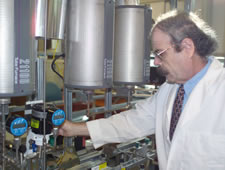A team of FSEC researchers is currently examining ways to use local renewable resources like landfill gas in the production of hydrogen. The research is a component of FSEC's NASA-funded project that supports the hydrogen-related space and space launch activities at the Kennedy Space Center.
According to FSEC's hydrogen division director Ali Raissi, "A lot of people have researched various ways of producing hydrogen over the years. But interestingly, because we have the Kennedy Space Center's launch pads virtually in our backyard, we looked at production options a little differently than others have, and we came up with the idea of using the landfill gas."
 |
Nazim Muradov tests the pilot-scale hydrogen production unit.
(Photo credit: Nick Waters) |
Nazim Muradov, who has been studying catalytic hydrogen production since 1990, leads the research effort, which has focused on the best way to produce hydrogen to meet the fuel needs of the space shuttle. "Commercial steam methane reforming is always a first choice," Muradov explained, "but relying on such an unpredictable resource as natural gas and dumping all the associated CO2 emissions into the atmosphere, was clearly not something we wanted to do."
Researching non-traditional, renewable resources of feedstock, Muradov visited the local landfill site where he learned that gas from the waste is burned to keep the methane out of the air. "There is enough potential fuel in our landfills to meet the spaceport's propellant needs for the next 50 years," he noted. In fact, one local landfill site within 15 miles of the space center could produce enough hydrogen for eight shuttle launches per year, according to Muradov's calculation.
With a grant from NASA's Glenn Research Center, the FSEC team began small-scale testing of catalysts for this strategy. They then developed a process for direct reformation of landfill gas into hydrogen. The bench-scale experimental tests and modeling studies have led to pilot-scale testing on a 1-SCFM (standard cubic feet per minute) production unit.
"Converting landfill gas to energy uses - heat and electricity - is nothing new," Raissi added. "Where I see the huge value from it, though, will be when we truly have a hydrogen economy in place and the demand for hydrogen is strong. Right now, the idea fits with NASA's need for rocket fuel. But what is so appealing for this process is that it produces hydrogen right where it is needed using the waste that people generate. People generate waste, and that very waste can be turned back into the fuel they need."
The research to date has been very promising, developing a way for NASA to meet today's needs for space fuel. In the future, though, the development of a hydrogen economy in the U.S. will make the promise of hydrogen production from landfill gas and other renewable sources a potentially major source of energy for everyone.
